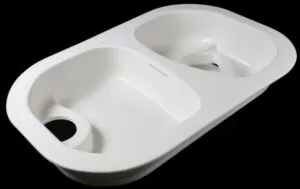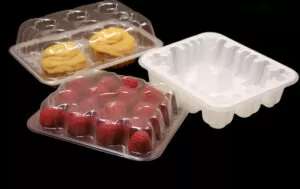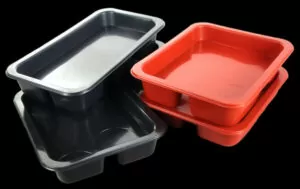Like plastic injection molding, thermoforming is a manufacturing process that creates plastic products by heating a plastic sheet until it is malleable enough to be molded over a mold, and then cooling it. The relationship between thermoforming and the various tools involved in the process is both deep-rooted and multifaceted. Converting design concepts into finished products is critical to thermoforming, but there’s more to this blog than meets the eye. In this blog, we focus not only on the final tool in thermoforming (the male or female mold used during the forming process), but also on other auxiliary tools that often play a vital role in helping to deliver high-quality parts .
In this guide to thermoforming, we not only look at the final tool in thermoforming (the male or female mold used during the forming process), but also the other ancillary tools that often play a vital role in helping deliver high-quality parts role.

Before diving into other tools in the thermoforming process, it’s important to understand the basics of the thermoforming process. Thermoforming has many uses; for example, it can produce anything from general retail and packaging to complex aircraft instrument panels. Features such as texture, loose and pneumatic cores, and inserts are also available. This adaptability comes from the diverse process technologies of thermoforming (vacuum forming vs. pressure forming, etc.), which have different characteristics and what they are particularly good at making!
When it comes to thermoforming, there is no standard production process. Producing different products often means adjusting many aspects of the production process so that each product is produced exactly as required. This may involve more than just what happens during the molding process: for example, if we want to fully understand the role of various other tools or auxiliary tools in the thermoforming of plastics, other factors related to tool use must also be considered!

Thermoforming Process
Thermoforming is a meticulous process in which a thermoplastic sheet is carefully heated to the right temperature where it can be easily formed, and then stretched over a mold so that it takes on the desired shape.
After cooling, the newly formed part can simply be removed, retaining its new shape! This transformation seems simple, but the process is actually very complex, involving the joint operation of heat, materials, tools, vacuum and other aspects. Some tools used in the thermoforming process can even directly affect the accuracy, speed and overall success of the product.
There are several thermoforming methods used in actual production: differential pressure molding, cover molding, plunger-assisted molding, suction back molding, opposite mold molding, female mold and male mold thermoforming, thin gauge thermoforming, heavy gauge(thick gauge) vacuum forming and twin sheet forming.

Thermoforming is a key manufacturing process that involves heating a plastic sheet until it becomes pliable, shaping it to fit a mold, and then trimming it to form the product’s final shape. The entire process can be further divided into a number of key sub-steps:
The Main Process
1. Sheet Heating
A plastic sheet is heated until it is softened enough to be easily formed (pliable).
2. One-Shot Forming
Vacuum or pressure either draws this now deformable heated piece of plastic into the mold, or it is pressed against the mold by mechanical forming means such as a pneumatic/hydraulic activated plug.
3. Cooling
Cooling after initial molding (sometimes referred to as “molding”). Air or water cooling systems cool these newly formed objects, causing them to harden until they harden and retain their new shape.

4. Trimming and Finishing
Trimming and finishing is usually performed after cooling, with excess material trimmed away, leaving the final part – although further finishing may still be required, such as drilling holes precisely where needed, cut things smaller if necessary, etc!
Thermoforming involves several stages of manufacturing finished parts from plastic sheets. The type of tooling used affects each stage and can lead to various sub-processes in thermoforming.
Primary Tooling in Thermoforming
The main player in the thermoforming process is the mold. They decide the shape of the final product, whether any small details can be preserved, and the overall quality. Molds can be made from different materials – cast aluminum molds, wood molds, or even cost efficient composite materials(composite molds). The choice of mold is not arbitrary; rather, it requires a careful choice because this decision affects many things: how long the tool can be used before needing to be replaced; whether the finished part has surface defects, etc.

Of course, the thermoforming process does not only require molds. The heating, vacuum and subsequent trimming processes in the process all require the assistance of other tools to complete the process to achieve the purpose of producing perfect products.
Core Tooling and Its Role
The main equipment used to shape plastic materials in thermoforming is called the core mold. It includes several types of tooling, including molds, plugs and plug assists, and pressure boxes (for pressure molding).
Molds
These are the negative molds of the product around which the plastic will be formed. They can be open-topped, fully enclosed, or include moving parts for more complex formations.

Plugs and Plug Assists
These are used for plug molding where pressure or vacuum alone may not achieve the desired shape. They help stretch the material into the shape of the mold.
Pressure Boxes
Specialized for pressure molding, these pressure boxes distribute consistent air pressure evenly over the plastic.
These tools are an integral part of the initial plastic molding process and are designed precisely to product specifications.

Additional Tooling and Equipment Beyond Molds
Molds may be essential to thermoforming, but they are not everything. Other important tools come into play when designs are complex or require extra help to form accurately and effectively.
Cutting and Trimming Tools
After the initial molding process is complete, parts often require further operations such as cutting and trimming. These steps are just as important as the molding itself, as they ensure there is no excess material on the components, give them neat edges, and prepare them for subsequent manufacturing.
There are a variety of tools that can be used to make cuts or trims after initial shaping, and each tool has its own advantages, depending on what exactly is required. Sometimes a non-complex shape may only require what is called a die cut; other times a laser/water jet may be used so intricate and precise work can be done and more complex patterns created as needed!

Temperature Control Systems
Temperature control is extremely important when thermoforming because it helps ensure that the material reaches the optimal state for molding. There are many different types of temperature control systems available: basic thermoforming projects may only require a simple radiant heater, while more complex jobs with large or complex molds can benefit from using one of these ingenious setups, regardless of whether the mold has No matter how big it is, it can maintain precise temperatures.
Plug Assists
Sometimes it is necessary to apply more force when shaping a part than the material can withstand without causing damage. Inlet plug assist tools help solve this problem by providing additional support throughout the molding process; they help ensure that material is distributed evenly, wall thickness is uniform, and the final product maintains its structural integrity.
Such tools come in many shapes and sizes – made from a variety of materials such as wood or machined aluminum extrusions; sometimes even foam will work well, depending on what thermoplastic you’re trying to achieve!

Robotics and Automation
The use of robotics and automation in thermoforming has brought significant changes. Such advanced systems are capable of performing tasks that are repetitive, non-hazardous or require extremely high precision. Integrating robotics into thermoforming can greatly improve the speed and consistency with which things happen; it also makes it safer overall for manufacturers and operators.
Automation is especially useful when it comes to tasks like moving materials during the molding process, removing finished parts from the production line, or performing secondary machining tasks afterward, but there’s another benefit: By using robots (rather than relying solely on humans), companies can Reduce reliance on labor and associated performance changes.

Additional Tooling Elements and Their Functions
In addition to the main tools, there are several other types of equipment that can help with each stage of thermoforming:
Clamping Frame and Handles
The clamping frame and handles hold the sheet in place during the heating process so that it does not sag or tear prematurely. They are also providing support during this time.
Ceramic and Coated Heaters
Ceramic and coated heaters heat plastic sheets evenly – without affecting their performance!

Cooling Tools and Platforms
Once molding is complete, cooling units and platforms come into play; they ensure everything cools quickly (and at an even rate). This helps prevent distortion in the finished product while also reducing the overall time of each cycle.
Cutting Plate and Trimming Presses
Cutting Plate and Trimming Presses provide a method of precise removal of excess material; by doing so, manufacturers can obtain the final profile/contour precisely as per the specification document.
Industrial ovens and calibration equipment
Industrial oven calibration equipment/care equipment also fall into this category! These items can be used as part of the preparation before heating begins, or during the cooling phase after heating has begun.

These tools enable workers involved in plastic manufacturing to achieve the desired results more efficiently. Of course, each of the above components fulfills its own specific functional/system role during the thermoforming process: if any one is missing (or fails to perform properly), then product quality will suffer. As production efficiency decreases, levels will been greatly affected.
Custom Tooling Solutions
Not all products produced by thermoforming can have their production needs solved with existing tooling. For some unique or customized products, proprietary custom tools may be the best way to solve the problem. Products or parts with high quality, high performance or high precision requirements usually use customized tools to meet their needs.
For example, custom molds can be made to fit existing thermoforming machines, custom cutting and trimming tools can be designed to handle challenging shapes, and custom temperature control systems can be implemented to ensure the process is fine-tuned to suit the production of the target product.

The Economic Perspective
Investing in additional thermoforming tooling must be a business decision based on the manufacturer’s financial situation. While there are significant costs associated with purchasing tools up front, these costs need to be compared with the benefits they bring over time: a better product, a smoother running system, or being more competitive in a changing market.
When considering the overall cost of a product over its life cycle, spending more money on additional tools often makes good financial sense. If a business purchases top-notch tools, they will likely save cash on future production costs because the products will last longer and require fewer repairs or replacements—all of which add up when calculating the total cost of ownership. stand up. Smart investment choices like this should also help the company do well in this competitive market!

Conclusion
The thermoforming process can be viewed as involving a complex interweaving of materials(high molecular weight polyethylene, high density polyethylene, polyethylene terephthalate, PVC, PC), heat, and tooling to complete the entire operation. Although molds are the primary tools used, there are many other tools and equipment that help create high-quality parts with tight tolerances. Extra tools or aids are especially important in industries like aerospace or medical equipment where precision is critical! Cutting and trimming aids; Temperature control systems (water-based or oil-based); Plug assistance… All these things and more play their own important role when you get your thermoforming job done right.
The overall tooling requirements during the thermoforming process, from main tools to custom tooling, can have a real impact on product quality and the smooth running of production. By understanding the role of molds and taking a strategic approach to mold investments, manufacturers can unlock the full potential of the thermoforming process.

In the quest for innovation and quality in thermoforming, the role of tooling should never be underestimated. It is not just a means to an end but a vital part of the process that can make all the difference.
Tooling is not an afterthought in thermoforming; it is the silent partner that lends structure to the process. The precision and functionality of these tools are reflected in the quality of the products they help create. Investment in the right tooling and a comprehensive understanding of its role fosters efficiency, growth, and product innovation within the thermoforming industry.

Understanding the intricate link between tooling and thermoforming is key to producers who seek to unlock the full potential of this versatile and time-tested process. By recognizing the value tooling adds at each step of thermoforming, manufacturers can fine-tune their operations, improve their products, and drive success in an increasingly competitive landscape. With continuous advancements in tooling technology and a commitment to sustainability, the future of thermoforming shines brightly, tool in hand.







